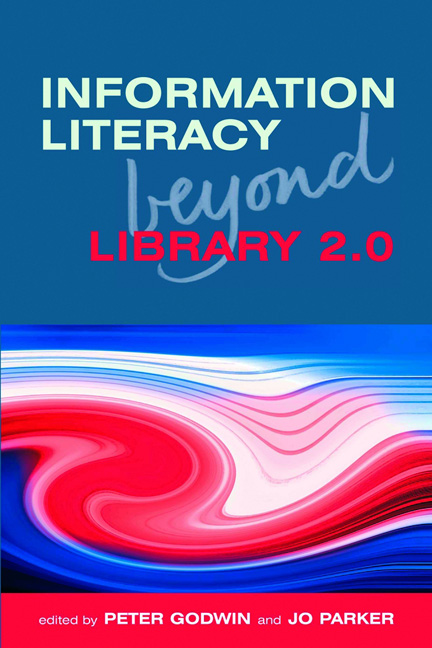Book contents
- Frontmatter
- Contents
- Contributors
- Acknowledgements
- Introduction
- PART 1 RECENT DEVELOPMENTS IN INFORMATION LITERACY AND LIBRARY 2.0
- PART 2 CASE STUDIES
- 7 Reinventing information literacy at UTS Library
- 8 Using games as treatments and creative triggers: a promising strategy for information literacy
- 9 Changing the conversation: introducing information literacy to a generation of smartphone users
- 10 Tweets, texts and trees
- 11 Referencing in a 2.0 world
- 12 Moving information literacy beyond Library 2.0: multimedia, multi-device, point-of-need screencasts via the ANimated Tutorial Sharing Project
- 13 Informed cyberlearning: a case study
- 14 An online course on social media for student librarians: teaching the information skills and literacies of social media
- 15 Transliteracy and teaching what they know
- 16 ANCIL: a new curriculum for information literacy: case study
- 17 TeachMeet: librarians learning from each other
- PART 3 WHAT IT MEANS FOR INFORMATION PROFESSIONALS
- Index
14 - An online course on social media for student librarians: teaching the information skills and literacies of social media
from PART 2 - CASE STUDIES
Published online by Cambridge University Press: 09 June 2018
- Frontmatter
- Contents
- Contributors
- Acknowledgements
- Introduction
- PART 1 RECENT DEVELOPMENTS IN INFORMATION LITERACY AND LIBRARY 2.0
- PART 2 CASE STUDIES
- 7 Reinventing information literacy at UTS Library
- 8 Using games as treatments and creative triggers: a promising strategy for information literacy
- 9 Changing the conversation: introducing information literacy to a generation of smartphone users
- 10 Tweets, texts and trees
- 11 Referencing in a 2.0 world
- 12 Moving information literacy beyond Library 2.0: multimedia, multi-device, point-of-need screencasts via the ANimated Tutorial Sharing Project
- 13 Informed cyberlearning: a case study
- 14 An online course on social media for student librarians: teaching the information skills and literacies of social media
- 15 Transliteracy and teaching what they know
- 16 ANCIL: a new curriculum for information literacy: case study
- 17 TeachMeet: librarians learning from each other
- PART 3 WHAT IT MEANS FOR INFORMATION PROFESSIONALS
- Index
Summary
Introduction
[W]eb 2.0 tools such as blogs, wikis and social networking sites … have become important tools for equipping new library and information science (LIS) graduates with the competencies and skills that fit with the dynamic, changing information market.
(Al-Daihani, 2010)This chapter describes the development of a new online course on social media offered by the School of Library, Archival and Information Studies (SLAIS) at the University of British Columbia in Vancouver, Canada. The creation of a course on an information and communication technology (ICT) topic involves consideration of many theoretical, practical and structural matters, and it requires perseverance on the part of instructors with regard to devising content. Social media, and how library and information professionals use them to serve users, is a constantly shifting domain. The field itself is incredibly volatile. A few social media tools seem stable enough (think of Facebook, Wikipedia or Twitter), but generally speaking, new tools appear (and disappear) with regularity. Not surprisingly, it complicates the teaching of a subject when there is a lack of evidence and the components making up the whole landscape shift regularly. As a set of tools for learning, technology is rarely enough to ensure that learning will take place (Bawden et al., 2007). On the contrary, in teaching the use of specific tools, the instructor should emphasize skills and literacies over discrete tasks (Secker, 2008; Giustini, 2008).
And so it is with social media. The two learning objectives that arose repeatedly in the development of this course were: 1) the importance of exposing students to new digital formats and channels of information on social networking sites; and 2) critiquing the use of social networking tools in the provision of information services. In addition, the course makes an effort to focus attention on assessing the quality, accuracy and relevance of information found through social media. Fortunately, developing content is an iterative, dynamic process – and with each new offering, the instructor has a chance to ‘get it right’. My chapter is a reflection on these scholarly matters and on what I have learned from teaching LIS students about social technologies.
- Type
- Chapter
- Information
- Information Literacy Beyond Library 2.0 , pp. 151 - 162Publisher: FacetPrint publication year: 2012

